Air Sealing/Insulation Questions
Hi All,
I really need to seal some air infiltration points in my house before my heating bill goes sky-high! Sorry for the long post. Any help you can offer would be greatly appreciated! (Please see my profile for some background on my house and my skills.) Basically, I have a rear room on my first floor that is unfinished, with cold air simply flowing in. (Most of the work in these pictures was done by the previous owners. Only the sloppy spray foam application is mine 🙂 )
There are gaps between the exterior sheathing planks that allow some air in, although I’ve foamed the worst of these. The biggest culprit is the open joist cavities in the ceiling of this room, towards the front of the house. I’m assuming, since this is an old house (circa 1930), it has no insulation in the walls and quite a few leaks, as well. I have a whole house fan in the attic that I’ve used to verify where the air is coming from. It really creates quite a wind coming out of those joist cavities. I’d like to block that airflow, keeping the cold air in the (relatively) sealed off floor and walls. I’m not in a position now to reside the house and fix those leaks from the outside, so simply keeping most of that air out of my living space will have to do.
After some reading, I’ve decided I could probably use pieces of rigid foam board placed as blocking into those joist gaps and sealed with spray foam around the edges. What do you all think? From what I understand, foam board is not good as a fire block. Does that matter in this case? Should I use something else? The previous owners simply stuffed some FG insulation into some of these joist cavities, but what they did still leaks a bit (I guess since it is only FG).
After I get those joist cavities sealed off, I’d like to finish sealing as much as I can in the unfinished exterior walls. I’m guessing I should just continue with spray foam in any gaps I can detect. Does that make sense? Also, there are a couple spots where air is leaking past some FG insulation. For example, at the top of the unfinished walls, the FG from the wall in the room on the 2nd floor is peeking down (with air leaking down around it. Is it OK to spray more foam right onto the FG or around it or is it better to put some type of rigid blocking (foam board, wood, etc.) across the bottom?
After the air leaks are sealed, I’m thinking I’ll just use FG batts to insulate the walls (with plastic sheeting over that as the vapor barrier), although I am concerned that may be difficult since the stud spacing isn’t standard (many sistered studs to square up the room for drywall, I’m assuming). I do know that professionally installed spray foam would probably be great in this case (for the air leaks and insulation), but I’m on a tight budget 🙂 Any thoughts?
Below are some pictures to clarify what I’ve been going on and on about.
Thanks!
Justin
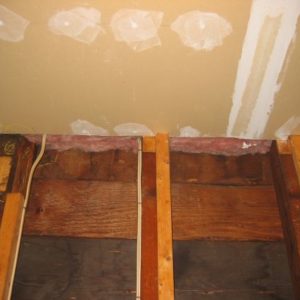
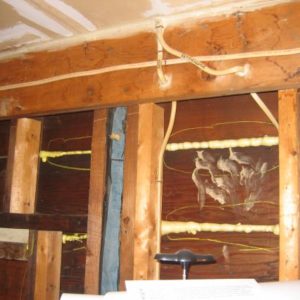
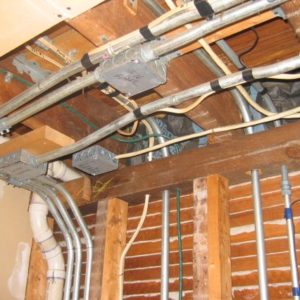
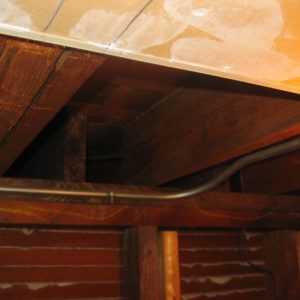

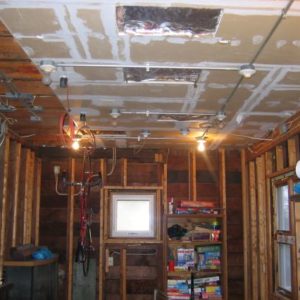



















Replies
Justin
Yikes.
What is on the exterior walls on the outside? Is it wrapped with Tyvek or something to keep the walls from pushing air? (rather than keep on foaming)
Anyway, floor joist bays are not required to be firestopped except where open bays tie to the wall system above or below.
I guess since technically all the joist bays are open to the room below (since it is not drywalled) then they should be blocked in the mean time. (till the ceiling is completely drywalled)
The foam board and spray foam method works very well and is effecient at both draft stopping and giving a little r-value.
re. the drafts, you should try to tackle as many of them as you can at the exterior envelope of the structure. Can you figure out why so much air pours thru the joist bays. If you can seal it at the exterior wall, that is ideal. (sealing it between that room and the other rooms means that the cold air will still be moving under the floor of the other rooms and will find a way to seep into the interior of the home.
Why so much electrical conduit? I'd want to loose the conduit, run it in MC (Romex) up in the ceiling and get some sheetrock on that ceiling.
By the way, fiberglass is really good in dead air spaces. When there is air movement, fiberglass doesnt work as the air will pass right thru it.
Sealing with foam, exterior wraps, caulks, overlapping materials, etc. is the best method to stop air movement.
Good luck and get out the extra heavy sweaters.
Its cold in these here eastern parts.
Jeff in PA (not too far north of you shivering in the kitchen)
Hi Jeff,"What is on the exterior walls on the outside? Is it wrapped with Tyvek or something to keep the walls from pushing air? (rather than keep on foaming)"- We've got aluminum siding over 8" planks, rather than plywood sheathing. There are 1/4" to 1/2" gaps between the planks, but I can see some sort of tar-paper looking material through these gaps. The worst leaks through these gaps were in an area that lead to the roof interior over the rear porch. Elsewhere, where there's siding on the outside, the leaks are pretty small."re. the drafts, you should try to tackle as many of them as you can at the exterior envelope of the structure. Can you figure out why so much air pours thru the joist bays. If you can seal it at the exterior wall, that is ideal. (sealing it between that room and the other rooms means that the cold air will still be moving under the floor of the other rooms and will find a way to seep into the interior of the home."- Yeah, I do realize that blocking the cold air from flowing down into my rear room out of those joist bays will still allow the interior of my walls and floors/ceilings to be cold, but I figure it'll still be a big help. I'm not sure where it's leaking in. I'm guessing there are just a bunch of small leaks through the siding/plank sheathing around the walls (just like the small leaks I can easily get to now in my unfinished rear room). Kind of hard to get to now, I'm thinking :) The siding is getting pretty old, so I may have a chance to (be required to :) ) better seal the outside when I reside (in 5 or 10 years)."Why so much electrical conduit? I'd want to loose the conduit, run it in MC (Romex) up in the ceiling and get some sheetrock on that ceiling."- What you suggest is exactly what I want to do. The previous owner was an industrial electrician (if that has anything to do with the seemingly excessive conduit). Also, that room was going to be a kitchen with a drop ceiling, so I guess he felt fine leaving all of that mess hanging out below the partial drywall. You may notice those gray tubes sticking down out of the drywall in the OverallWest view (with some coiled red wiring, too). Those are part of the planned whole-house vac (not my plan). I'll be yanking those out, too :)Thanks for all the advice! At least it's warming up now -- it's in the 30's today. (Note to all of you in the REALLY cold parts of the country: I'm not complaining about our 10-18 degree days. I don't know how I'd cope with -30 degrees. :) )Cheers,
Justin
Justin.... What part of the city are you in?
Hi,I live in Lauraville (just south of Hamilton) near Harford and Echodale -- NorthEast Baltimore.Cheers,
Justin
Follow what Jeffin recommends, he's right on the money.
Justin Fink - FHB Editorial